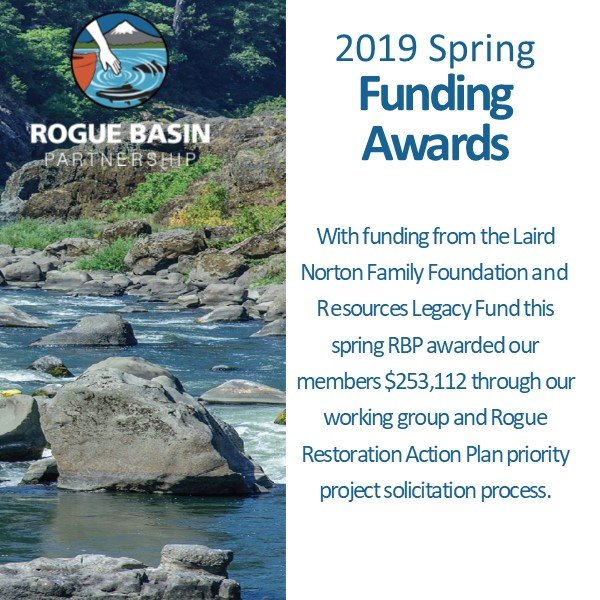No single organization can restore the Rogue Basin on its own. To recover our native fisheries and protect the unique biodiversity of our forests, strong collaborations are needed, and local leadership must be supported. One way that RBP supports stewardship of our Basin is by seeking out financial resources to enhance the success of our member/partner organizations. With funding from the Laird Norton Family Foundation and Resources Legacy Foundation, this spring RBP awarded our members $253,112 through our working group and priority project solicitation process.
This year’s funding will support the following projects:
Conservation Policy. Working group members (Rogue Riverkeeper, Water Watch of Oregon, and the Native Fish Society) will advance the development of a scientific report that will provide support for increasing the size of no-cut stream buffers on private forestlands. Working group members aim to protect streams that support salmon, steelhead, and bull trout in the Rogue watershed; monitor weekly public notices for water rights development; host quarterly working group meetings, and meet with RBP members to discuss 2019 policy issues.
Cooperative Weed Management. The Josephine County Soil and Water Conservation District will support ongoing invasive weed management efforts in Josephine County by contracting the Cultural & Ecological Enhancement Network (CEEN) to survey and treat Dyers Woad and supporting two Let’s Pull Together volunteer stewardship events.
Monitoring. Led by the Rogue Valley Council of Governments, monitoring working group members (Rogue Riverkeeper, Rogue River Watershed Council, Lower Rogue Watershed Council, and the Jackson Soil & Water Conservation District) will update the Rogue Basin Monitoring Plan to include recommendations for riparian monitoring, updated maps, gap identification, capital improvement plans.
Native Species & Habitat. The Applegate Partnership and Watershed Council and working group members (Rogue River Watershed Council, Lower Rogue Watershed Council, The Freshwater Trust, and the Cow Creek Band of Umpqua Tribe of Indians) will produce a Habitat Restoration Guide for Incorporating Non-target Species.
Riparian. The Applegate Partnership and Watershed Council and working group members Rogue River Watershed Council, The Freshwater Trust, Jackson Soil and Water Conservation District, Lomakatsi Restoration Project, Illinois Valley Soil & Water Conservation District, Rogue Valley Council of Governments, and the Klamath Bird Observatory) will seek support for a riparian ordinance blanket permit; engage title companies and county planning departments in conversation about riparian ordinances; and develop a strategy for collecting riparian condition information from partners across the Basin.
Rogue Native Plant Partnership. Funding will provide capacity for RBP’s contracted coordinators to collect and disseminate key information from RNPP partner organizations; develop a searchable database where this information will be stored and organized: a “lessons learned” and “best practices” page for land managers and growers on RNPP’s website: and an improved system for prioritizing volunteer seed collection events.
Barrier Removal. Funding will support the Applegate Partnership and Watershed Council, Rogue River Watershed Council, Illinois Valley Watershed Council, and Water Watch of Oregon’s efforts to engage landowners, negotiate project agreements, and implement fish passage projects at 18 different sites throughout the Rogue River Basin.
Beaver Intrinsic Potential Habitat Modeling (Priority Project). The Applegate Partnership and Watershed Council will complete GIS modeling and ground-truthing for the Beaver Intrinsic Potential. The completed model will provide partners with a list of suitable beaver release sites and lay the groundwork for potential relocation to these areas before problems occur.
Ashland Creek Fish Passage Improvement Project (Priority Project). The Rogue River Watershed Council will remove the Smith-Meyer-Roper diversion dam and replace the structure with a re-profiled stream channel made of boulders and engineered stream bed material and build a new concrete diversion headworks and gate to permit irrigation water diversion.

